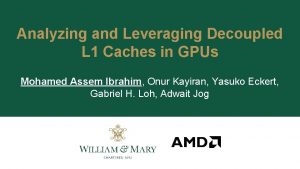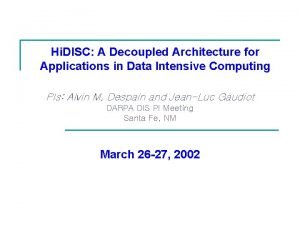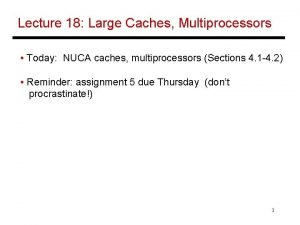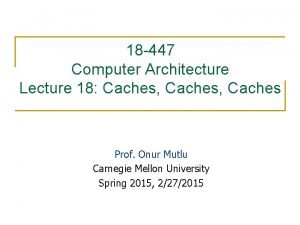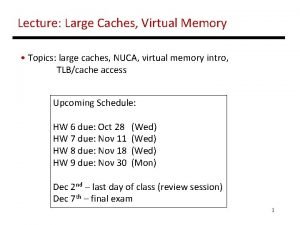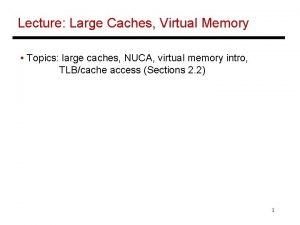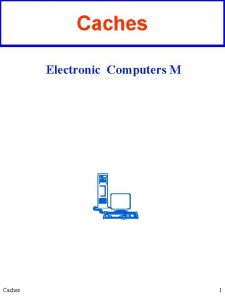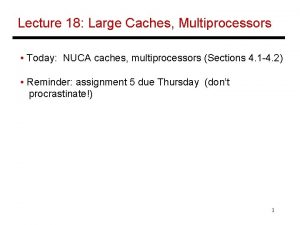Analyzing and Leveraging Decoupled L 1 Caches in













- Slides: 13

Analyzing and Leveraging Decoupled L 1 Caches in GPUs Mohamed Assem Ibrahim, Onur Kayiran, Yasuko Eckert, Gabriel H. Loh, Adwait Jog

State of GPU Computing GPU Scaling Trends • GPU die sizes are getting larger • Core count is increasing as well 700 Die Area (mm 2) 600 500 400 300 200 100 2015 2013 2011 2010 2009 2008 2007 2006 2005 2004 2003 2002 2001 2000 1999 0 Year Wikipedia (Data) 2

State of GPU Computing Challenges with Large-Scale GPUs 2 Replication of data (cache line) across L 1 caches Private L 1 Core Core Core L 1 L 1 L 1 1 L 1 bandwidth is underutilized & L 2 bandwidth is a bottleneck! Reply Network-on-Chip (No. C) L 2 L 2 Memory 3

Conventional Cache/No. C Hierarchy Solution? • Improving L 1 bandwidth utilization and reducing data replication requires: – No. C overhead to enable inter-core communication – Disrupting the Home core • Arbitration between local and remote requests Core L 1 No. C L 2 Memory Problem Source: Tightly-coupled GPU core and L 1 cache! 4

Decoupled L 1 Caches (DC-L 1 s) • Separate L 1 cache from the GPU core. – Break the tight-coupling! Lite GPU Core (No L 1 Cache) 0 1 2 3 4 5 … A-2 A-1 Level-1 Cache C-2 C-1 Level-2 Cache No. C#1 (Core ↔ DC-L 1) DC-L 1 (Decoupled L 1) 0 1 2 3 4 5 … Two-level Cache Hierarchy No. C#2 (DC-L 1 ↔ L 2) L 2+Memory 0 1 2 3 4 5 … 5

Aggregating DC-L 1 Caches Lite Core • Merge X DC-L 1 s to form one bigger DC-L 1 cache. • Reduced replication • Better L 1 bandwidth utilization • Lower peak L 1 bandwidth Assume 80 -core System with 80 DC-L 1 s (Example of aggregating two DC-L 1 s) 2 x 1 XBar 2 X Size 0 0 L 2 3 … 2 x 1 XBar 1 … 38 39 2 1 0 DC-L 1 1 79 78 40 x 32 XBar 0 1 2 … 31 30 Pr = Aggregate 2 DC-L 1 s 40 Aggregation Granularity? IPC Boost + Reduced Area/Power Low Replication Reduction 6

Shared DC-L 1 Caches Assume 80 -core System with 40 DC-L 1 s (Aggregation Granularity = 2) • Shared cache organization across DC-L 1 s. Lite Core 3 2 1 0 – Eliminate replication. • Use 80 x 40 crossbar in No. C#1. DC-L 1 L 2 … 79 78 80 x 40 XBar 2 X Size … 1 0 – Enable communication between a given core to all DC-L 1 caches. 39 38 Unique Addr. Range Slice 40 x 32 XBar 0 1 2 … 31 30 Sh 40 = Significant IPC Boost Area/Power Overheads + Poor-performing Applications 7

Clustered Shared DC-L 1 Caches Assume 80 -core System with 40 DC-L 1 s (Aggregation Granularity = 2) Lite Core • Shared cache organization across a cluster of DC-L 1 s. – Eliminate replication within a cluster. – Limit overall replication. • Use smaller crossbars in No. C#1. – Enable communication between a given core to all DC-L 1 caches in a cluster. … 1 0 … 7 Unique Addr. Range Slice 2 1 0 0 2 1 C 0 C 1 C 2 C 3 C 9 1 0 1 7 … C 9 10 x 8 XBar 2 2 39 C 0 C 1 C 2 C 3 10 x 8 XBar 0 39 38 37 36 … 79 8 x 4 XBar 3 3 … 73 72 … 8 x 4 XBar L 2 DC-L 1 7 25 24 … 24 25 31 26 26 … 31 Clusters Count? Sh 40+C 10 = Choose 10 Clusters IPC Boost + Replication Reduction + Reduced Area/Power 8

0 1 2 3 80 x 40 8 x 4 XBar 4 3, 5 3 2, 5 2 1, 5 1 0, 5 0 80 x 32 7 40 x 32 … 8 x 4 1 2 x 1 0 Max. Frequency (GHz) Frequency-boost Optimization Crossbar • Smaller Crossbars = Higher Operating Frequency • Optimization Double the No. C frequency in No. C#1 Sh 40+C 10+Boost 9

Evaluation More results in the paper! IPC Normalized IPC Mean P-GEMM P-3 MM P-2 DCONV C C-NN F -B S FS R 2 -C F S- S- D R Q ed TC uc ti S- on P- Tr 3 D ia C d O N P- V 2 P- MM S T- YR A le K x T- T-R Ne Sq e t ue s. N ez et e. N e M t ea n 75% 1, 2 1 0, 8 0, 6 0, 4 0, 2 0 C-RAY 5 x Normalized IPC 4 3, 5 3 2, 5 2 1, 5 1 0, 5 0 C Poor-performing 8 x -B Normalized IPC Replication-sensitive 9 8 7 6 5 4 3 2 1 0 Pr 40 Sh 40 Applications • Results are normalized to Private L 1 organization baseline. • • Replication-sensitive Applications Average = +75%, Max = +8 X Poor-performing Applications Average = -5% 10

Conclusions • Observe an opportunity for decoupled L 1 caches in GPUs to break the tight coupling between the GPU cores and the L 1 caches – Reduce data replication across the L 1 caches – Improve L 1 bandwidth utilization • Achieved through the following: – Aggregated DC-L 1 caches to improve the L 1 bandwidth utilization – Clustered Shared DC-L 1 caches to limit data replication • Results – 75% IPC improvement for the replication-sensitive applications – 5% IPC degradation for the poor-performing replication-insensitive applications – 50% No. C area reduction because of the hierarchical design 11

Disclaimer & Attribution The information presented in this document is for informational purposes only and may contain technical inaccuracies, omissions and typographical errors. The information contained herein is subject to change and may be rendered inaccurate for many reasons, including but not limited to product and roadmap changes, component and motherboard version changes, new model and/or product releases, product differences between differing manufacturers, software changes, BIOS flashes, firmware upgrades, or the like. AMD assumes no obligation to update or otherwise correct or revise this information. However, AMD reserves the right to revise this information and to make changes from time to the content hereof without obligation of AMD to notify any person of such revisions or changes. AMD MAKES NO REPRESENTATIONS OR WARRANTIES WITH RESPECT TO THE CONTENTS HEREOF AND ASSUMES NO RESPONSIBILITY FOR ANY INACCURACIES, ERRORS OR OMISSIONS THAT MAY APPEAR IN THIS INFORMATION. AMD SPECIFICALLY DISCLAIMS ANY IMPLIED WARRANTIES OF MERCHANTABILITY OR FITNESS FOR ANY PARTICULAR PURPOSE. IN NO EVENT WILL AMD BE LIABLE TO ANY PERSON FOR ANY DIRECT, INDIRECT, SPECIAL OR OTHER CONSEQUENTIAL DAMAGES ARISING FROM THE USE OF ANY INFORMATION CONTAINED HEREIN, EVEN IF AMD IS EXPRESSLY ADVISED OF THE POSSIBILITY OF SUCH DAMAGES. ATTRIBUTION © 2021 Advanced Micro Devices, Inc. All rights reserved. AMD, the AMD Arrow logo and combinations thereof are trademarks of Advanced Micro Devices, Inc. in the United States and/or other jurisdictions. Other names are for informational purposes only and may be trademarks of their respective owners. 12

* We acknowledge the support of the National Science Foundation (NSF) CAREER award #1750667. * This presentation and recording belong to the authors. No distribution is allowed without the authors' permission. Thank You! Questions? Mohamed Assem Ibrahim maibrahim@email. wm. edu https: //massemibrahim. github. io/
 Analyzing and leveraging decoupled l1 caches in gpus
Analyzing and leveraging decoupled l1 caches in gpus L caches
L caches Decoupled software architecture
Decoupled software architecture Cert size up steps
Cert size up steps Leveraging subsidiary skills
Leveraging subsidiary skills Brand extension vs line extension
Brand extension vs line extension Leveraging social media for talent acquisition
Leveraging social media for talent acquisition Secondary brand knowledge
Secondary brand knowledge Brand leveraging
Brand leveraging What is secondary brand association
What is secondary brand association Leveraging coso across the three lines of defense
Leveraging coso across the three lines of defense Three lines of defense model
Three lines of defense model Louisiana leveraging educational assistance partnership
Louisiana leveraging educational assistance partnership Leveraging threat intelligence
Leveraging threat intelligence
